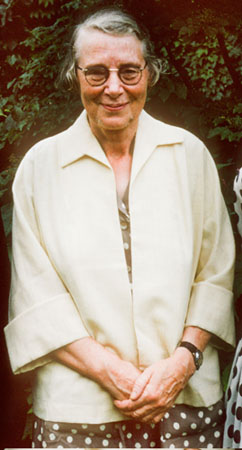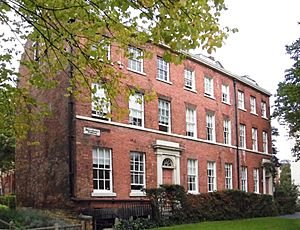Irene Manton facts for kids
Quick facts for kids
Irene Manton FRS
|
|
|---|---|
 |
|
| Born | 17 April 1904 Kensington, London
|
| Died | 13 May 1988 (aged 84) |
| Nationality | British |
| Education | St Paul's Girls' School |
| Alma mater | Girton College, Cambridge (PhD, 1930) |
| Awards | Linnean Medal (1969) Schleiden Medal (1972) |
| Scientific career | |
| Fields | Botany, Genetics, Electron microscopy |
| Institutions | Girton College, Cambridge University of Manchester University of Leeds |
Irene Manton (born April 17, 1904, in Kensington, London – died May 13, 1988) was an important British botanist. She became a Professor of Botany at the University of Leeds. She was especially known for her studies of ferns and tiny sea plants called algae.
Contents
About Irene Manton
Irene Manton was born into a creative family. Her father, George Manton, was a dental surgeon. Her mother, Milana Manton, was a talented embroidress and designer. Irene had a sister named Sidnie Manton, who became a famous entomologist (someone who studies insects).
Irene went to the Froebel Demonstration School and then to St Paul's Girls' School in London. Even as a schoolgirl, she was very interested in science. She read a book called The Cell in Development and Heredity by Edmund Beecher Wilson. This book sparked her early interest in chromosomes, which are tiny structures inside cells that carry genetic information.
Her Academic Journey
In 1923, Irene Manton started studying at Girton College, Cambridge. She later moved to Stockholm to study with Gustaf Otto Rosenberg. In December 1928, she began teaching at the University of Manchester. She earned her PhD in June 1930. Her research focused on a group of plants called Cruciferae, which includes plants like cabbage and mustard.
Most of Irene Manton's career was spent at the University of Leeds. She was a Professor of Botany there from 1946 to 1969. After that, she became a Professor Emeritus, meaning she kept her title after retiring. At Leeds, she focused on ferns and algae.
Studying Ferns and Algae
Her work on ferns looked at how different types of ferns mix together (hybridisation). She also studied how they reproduce in special ways (polyploidy and apomixis). This led to her 1950 book, Problems of cytology and evolution in the pteridophyta. Cytology is the study of cells.
Irene Manton also used special microscopes to study the tiny structures of cells. This was a big step towards her later work with the electron microscope. Her research on algae was especially famous because she used the electron microscope to see incredibly small details. She became known worldwide for showing the structure of cilia and flagella. These are tiny, hair-like parts that help cells move.
Irene Manton loved art. She gave her collection of modern and Asian art to the University of Leeds. Many of these artworks hung in Botany House while she worked there. She also helped supervise Evan Benjamin Gareth Jones, who later became a well-known mycologist (someone who studies fungi).
Awards and Recognition
Irene Manton received many honours for her scientific contributions.
- In 1969, she shared the Linnean Medal with Ethelwynn Trewavas. This is a very important award for botanists and zoologists.
- She was the first woman to be President of the Linnean Society of London. She held this position from 1973 to 1976.
- In March 1961, she was chosen as a Fellow of the Royal Society. This is a huge honour for scientists in the UK. She was recognized for her work on the super-tiny structures of plants and how they evolved.
- In 1969, she became an Honorary Member of the American Academy of Arts and Sciences.
- From 1969 to 1972, she was President of the British Pteridological Society, which focuses on ferns.
- In 1972, she received the Schleiden Medal from the Academy of Sciences Leopoldina.
Her Lasting Impact

Irene Manton's work continues to inspire new scientists.
- In 1990, the Linnean Society created the Irene Manton Prize. This award is given to the best doctoral thesis (a big research paper for a PhD) in botany in the UK.
- The Linnean Society also supports annual Irene Manton Lectures. These talks have been held at the University of Manchester and the University of Leeds since 2014.
- In 1998, ten years after her death, the Biological Sciences building at the University of Leeds was renamed the Irene Manton Building in her honour.
- The British Phycological Society gives out the Irène Manton prize every year. It is for the best presentation by a postgraduate student at their science meeting.
See also
 In Spanish: Irene Manton para niños
In Spanish: Irene Manton para niños


